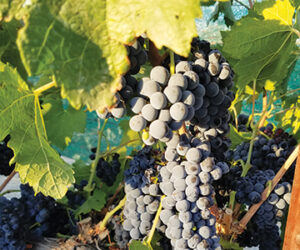I love offbeat reds! Not found at every package store or restaurant, these less common wines may be of historical interest, have a cult following, or just be good wine. If you get a chance to make something like this, give an offbeat red a try.
I have selected five wines: Carménère, Charbono, Dolcetto, Montepulciano, and Tinta Cão. When I call these varieties offbeat, it comes from my California perspective. Some of these have thousands of acres (hectares) planted elsewhere in the world, but commercial plantings in California are under 150 acres (61 ha) for each of them. Grapes like these also often have synonym names, leading to confusion in the wine marketplace. DNA research, pioneered by Dr. Carole Meredith at UC-Davis, has helped clear up several of these complexities. And I highly recommend diving into a copy of The Oxford Companion to Wine, edited by Jancis Robinson, for more info about these five varieties.
Feeling inspired to make some non-mainstream red wines of your own, but not sure where to source the grapes? Ask around amongst fellow winemakers — both in person and online, talk to your neighbors who make or enjoy wine, or check out importers of fresh grapes and frozen musts. Also, try wine kits for “offbeat” opportunities — there are many varieties that can be hard to source as fresh fruit, but chances are that a wine kit company has made it. If you get the chance to make something offbeat, I highly recommend it. You may amaze your friends and you will certainly add a unique experience to your hobby.
Carménère
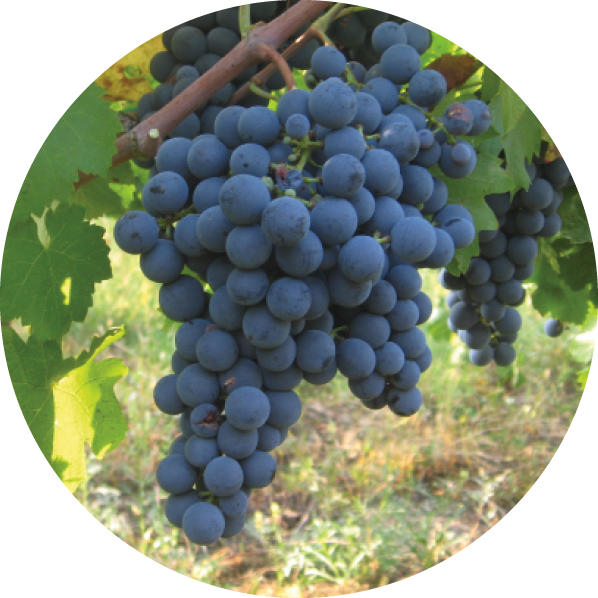
Carménère is one of the varieties used in the fine wine blends of Bordeaux, France, along with Cabernet Sauvignon, Cabernet Franc, Merlot, Malbec, and Petit Verdot. After the 19th century Phylloxera epidemic, far less Carménère was replanted than the other varieties. Prior to that, European immigrants in Chile had brought it to that country. Somehow along the way, it lost its identity in the relocatio
n and was widely considered to be a clone of Merlot, rather than a variety of its own. The growing characteristics, however, are quite distinct. Carménère ripens about two weeks later than Merlot, leading to difficulty for proper ripeness in inter-planted vineyards. If the Merlot is ripe, the Carménère will be under-ripe and if you wait for the Carménère, the Merlot will go overripe. It was not until 1994 that a French researcher in Chile recognized the variety for what it was.
Guenoc and Langtry Estates in Lake County is one of the places where Carménère got its start in California in the 1990s, but it has never truly taken off. In 2015, 74 acres (30 ha) were planted to the variety in the state. The grapes prefer a long growing season in a warmer area. Compared with the other Bordeaux varieties, yields are often lower with Carménère. In chilly, wet climates it is subject to coulure, a physiological problem that causes the grapes not to set at flowering.
In The Oxford Companion to Wine, editor Jancis Robinson compares Carménère wine favorably to Merlot and Cabernet Sauvignon. To look for a commercial example of this wine, you will have good luck in the Chile section of your local bottle shop.
My own making of Carménère comes from the Chilean side. I was leading a boot camp seminar on “Winemaking from Grapes” at the WineMaker Magazine Conference in Monterey, California in 2013. With no fresh California wine grapes available at that time of year, I turned to Musto Wine Grape Company for fresh Chilean grapes that they import in refrigerated containers to East Coast ports, and which they kindly sent by FedEx to the conference hotel for me. In the boot camp seminar, we crushed and destemmed the first 100 lbs. (45 kg) into a plastic bin to soak up for later pressing as Carménère rosé. The second 100 lbs. (45 kg) went into another bin to become red “Boot Camp Carménère.” We used macerating enzymes to improve extraction. I used Enoferm BDX yeast from Lallemand and we punched down twice a day for the remainder of the conference. I took the still-fermenting must with me and finished the wine at home. Since so little of this grape is grown in the United States, you may have your best shot at making some at home by sourcing imported Chilean grapes as I did. Or you can also source Chilean Carménère juice from wine grape suppliers such as Musto Wine Grape Company.
Tasting Notes
2013 Carménère, Chile: During a recent tasting with my fellow oenophile and winemaking buddy Eirene King, she noted a spicy aroma, with juniper and cedar notes. I was less kind to it, commenting on green bell pepper and pyrazines. It does show a nice, intense ruby color. Upon tasting, it exhibits a pleasantly creamy mouthfeel with smooth tannic grip. Not very fruity, but it shows refreshing cranberry tartness. As we went on with the tasting, this one rounded out and improved with air exposure.
Wine Kit Recommendations:
• RJS Craft Winemaking Cru Select Chile Style Cabernet Malbec Carménère
• Vineco Cellar Craft Showcase Carménère Chile
• Winexpert Selection Chilean Carménère
• Wine Kitz Carménère
• Wine Kitz Malbec-Carménère
Charbono
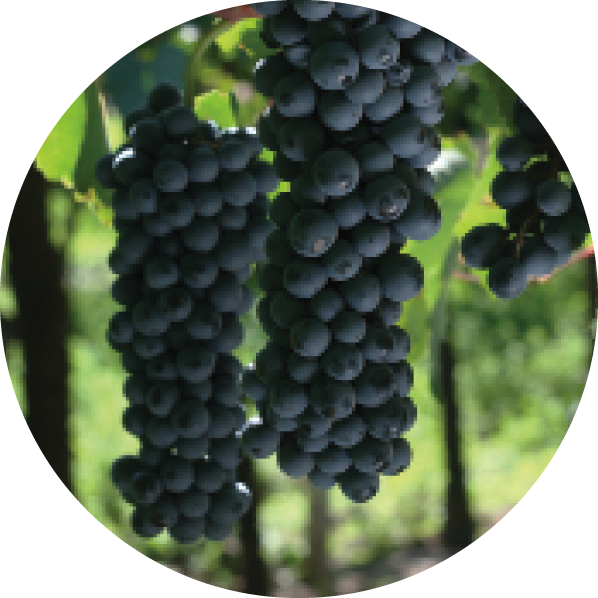
This variety, also called Douce Noir, Bonarda, or Corbeau, is from Italy. Or France. Or both. Originating in what is now the Savoie wine region of France, it was first planted there while the region was part of Italy prior to 1860. Very little remains in France today, but it is the second-most widely planted grape in Argentina after Malbec, with about 46,000 acres (18,600 ha). There, it is usually called Bonarda. Rumors to the contrary, it is not the same grape as Dolcetto. Dr. Carole Meredith showed in 1999 that Charbono/Douce Noir/Bonarda/Corbeau is not Dolcetto/Dolcetto Nero.
In California, there are currently about 75 acres (30 ha). It was first bottled as a varietal here in 1941 by Inglenook in Napa Valley. In California, besides Napa Valley and Mendocino County, there are plantings in the Sierra Nevada foothill counties of Amador, Placer, and El Dorado. There are also a few small vineyards in Central Valley locations like Lodi. These have in common a long, hot summer. Charbono is late ripening and requires heat to reach full physiological maturity. The wine is noted as excellent in food pairings because it combines a full fruity ripeness with soft tannins and bright acidity.
I have made this wine twice. Several years ago, Marty and I sourced Charbono grapes from Testa Vineyards in Ukiah, California Co-owner Maria Testa Martinson let me have 200 lbs (91 kg). Harvest weather was chilly and wet that year with the result that sugar was a bit low and acid a bit high. I was not using enzymes in my winemaking at that time, and color was not as intense as I would have liked. Nonetheless, we made a very drinkable food wine (see tasting notes).
My second opportunity with Charbono came in 2016. I had met Sonia Baron at the Sacramento Home Winemakers club a few years earlier. At the club’s holiday party in 2015, Sonia told Marty and me that she and three business partners had bought a nine-acre vineyard in Fair Play in Amador County. Varieties on the property included Malbec, Charbono, and the Portuguese varieties Tinta Cão and Souzao. We bought the grapes at harvest 2016, crushed, destemmed, and added sulfite and enzymes to the must. Charbono harvest characteristics were excellent at 24 °Brix and 6.4 g/L (0.64 g/100 mL or percent) titratable acidity (TA). Back home, I inoculated with ICV D254 yeast and applied FT Rouge Soft sacrificial tannins and Opti-Red inactivated yeast nutrients. Fermentation went very well over a period of 10 days and we pressed a very good yield of about 45 gallons (170 L). Malolactic fermentation with Enoferm Alpha bacteria completed in about three weeks, and I racked the wine to a used hectoliter (26-gallon) American oak barrel and some PET carboys. The wine is coming along very nicely.
Sourcing Charbono is a bit of a challenge, and there aren’t any wine kits on the market currently using Charbono juice. Your best bet is to locate local wineries that are producing Charbono and inquire — as I did — about buying some grapes.
Tasting Notes
2011 Charbono, Mendocino County, Testa Vineyard: Color is a bit light, as is the nose. Some spice, not much fruit in the aroma. Flavors of tart cherry, spice, black pepper, tobacco, and cigar box. A short finish. Altogether, a good light red table wine for food pairing. Air exposure opened up some additional rose petal aromas.
2016 Charbono, Amador County, Bom Vinho Vineyard (barrel sample): Deep purple color, much darker than the 2011. Plum in the nose, although again not a lot of fruit. This one still tasted “grapey” in its very young age. The wine showed the same tart cherry flavors as the 2011; likely a varietal characteristic. Pleasant tannins linger on the palate. A very rich young red.
Dolcetto
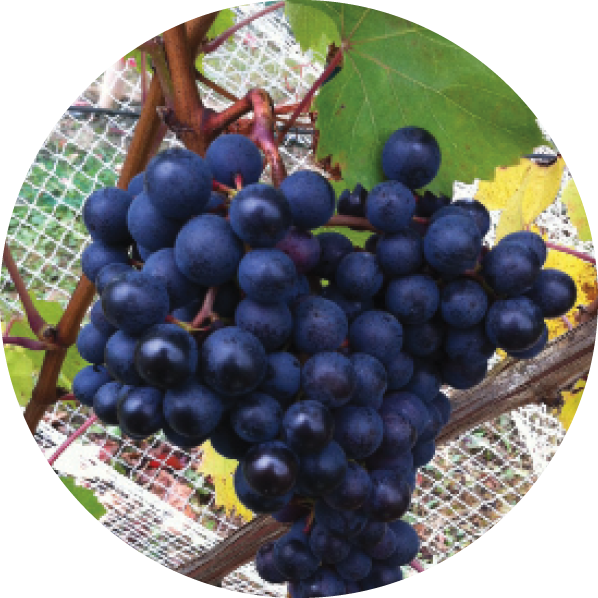
As noted earlier, despite some confusion, this grape is not Charbono. It is, however, widely planted in Italy. In the Piedmont region in the northwest, it is typically planted in cooler, less-favored sites while Nebbiolo and Barbera are given the best vineyard locations. While the latter two varieties are used to produce long-aged, premium wines, much of the Dolcetto goes into simple table wine intended for young consumption. In California, we find only about 106 acres (43 ha) of this variety in commercial plantings. These are widely distributed, with vines reported in Santa Barbara County, the Santa Cruz Mountains, Mendocino County, Napa Valley, and the Russian River Valley of Sonoma County. It is compatible with cool climates as it tends to be early ripening and is not expected to make “big” wines. Jancis Robinson notes in The Oxford Companion to Wine that Dolcetto wines are “soft, round, fruity, and fragrant.” She and other writers note the frequent presence of licorice and almond aromas in the profile. In spite of its meaning as “little sweet one” and its low-acid fruity nature, it is capable of a markedly tannic character as well.
With its wide distribution (although low acreage) in California, the wine is available from a number of different commercial producers. The first to catch my attention a few years ago was from Viansa Winery south of Sonoma. Produced from Sonoma Valley grapes, this wine exhibited a bright cherry fruit character with moderate acidity and well-controlled tannins. Priced at about $25 per bottle, it made for something very distinctive with an Italian meal served to guests at home. Another winery that makes excellent Dolcetto is Jacuzzi Vineyards, which is also in Sonoma. Across the street from, and owned by the same family as Cline Vineyards, Jacuzzi Vineyards specializes in wines made with Italian grape varieties. The 2013 Dolcetto is in current release for less than $25. Of course, there is a wide range of Italian Dolcettos on the market as well.
I have not yet made a Dolcetto, but I included it with this list because I am considering planting it in my hobby vineyard. I currently have one-third of an acre planted half to Pinot Noir and half to Chardonnay. I would like to plant another red variety, but my cool climate makes many reds problematic. It seems to me that “cool, less favored sites” and “early ripening” might be just what I need. I like the wines I have tried and think it could be worthwhile giving it a chance. In making the resulting wine, I would look to maximize the fruity freshness with the expectation of drinking the wine in its youth. For me, that would mean using enzymes with a good presence of beta glucosidases to help release fruity aromas. I would also watch closely to avoid excess tannin extraction, possibly pressing off at four or five Brix instead of my usual zero to shorten exposure to the skins and seeds. Color is generally very good with these wines, so early pressing may not be much of a compromise for that, while allowing a lower tannin extraction.
Your best bet for sourcing Dolcetto grapes for home winemaking is to reach out to commercial producers to inquire about purchasing a quantity of grapes at the next harvest. You might have to wait a harvest or two, but it’s worth asking. You could also try finding some hobby grape growers in your area or greater region who are into Italian varieties. Grape suppliers, such as Musto Wine Grape Company, also often have Dolcetto grapes and juice for sale. Presque Isle Wine Cellars in North East, Pennsylvania also annually stocks Dolcetto Italian Juice (for pickup only). There are unfortunately currently no Dolcetto wine kits on the market, but keep your eye on the wine kit market for any special releases or Italian-variety blends.
Montepulciano
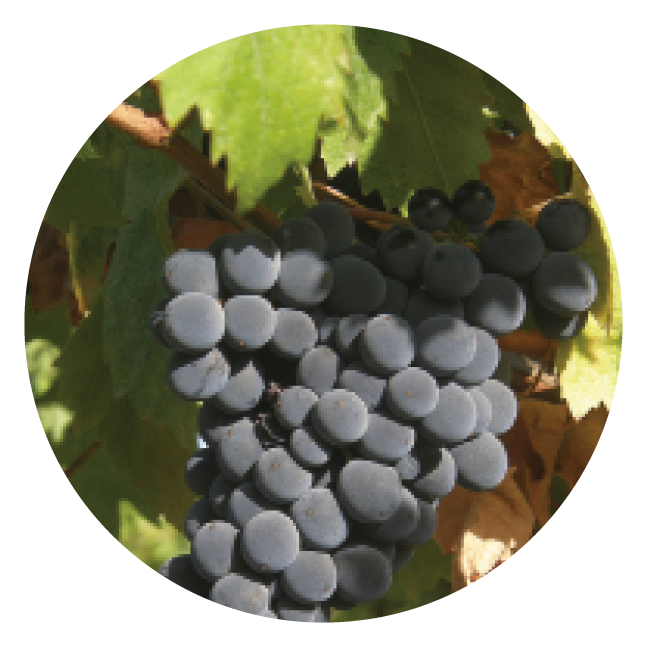
Montepulciano, the grape, runs into name confusion like other offbeat reds. There is a village in Italy called Montepulciano and wine grapes are grown all around it. Those vineyards, however, are mostly planted with Sangiovese, not the grape variety called Montepulciano. Elsewhere in Italy, thousands of acres (hectares) are planted to Montepulciano grapes.
In California, there are something like 108 acres (44 ha) of Montepulciano planted. It is a warm-climate variety and matures late, explaining why it is cultivated in central Italy, rather than further north in places that grow Dolcetto. Montepulciano can, however, do well in a coastal climate with cool breezes and a long growing season. Much of the best Italian wine from this variety is grown in provinces along the Adriatic Sea. Despite the small area of plantings in California, it is widely distributed from Mendocino County and Sonoma’s Carneros, to more inland areas like Alexander Valley and Amador County. It also finds a home in San Diego’s Temecula Valley, and there are plantings of it in Texas, Virginia, and North Carolina.
As a wine, Montepulciano is usually made as a simple table red. It is fruity, round, and balanced with moderate levels of tannin and acid. It is deeply pigmented and provides a refreshing, supple companion for rustic foods. Various versions of the famous Montepulciano d’Abruzzo from Italy can be found on the wine lists of almost all Italian restaurants and also in better bottle shops. It’s excellent with any roasted game, Italian tomato sauces, and more.
If you want to find a domestic version, you will have to look a little harder. My favorite local version comes from Jacuzzi Family Vineyards in Sonoma, California. The winery is in the Carneros region of Sonoma County, but the grapes for this wine were sourced from the Tracy Hills AVA. That region is located in both San Joaquin County and Stanislaus County on the western edge of California’s Central Valley.
When I set out to make a Montepulciano, I searched for local grapes. I talked to growers who came into my store, I checked online wine industry classified ads, and traded stories with other home winemakers. I could not find any. Since I really wanted to make this wine, I went an alternative route that may help you make an “offbeat red,” too. I bought a juice kit. The Mosto Italiano kit was from Canada, employing single-strength sterile juice from Italy. I followed the kit instructions exactly and I was very pleased with the results. Just as expected from the varietal, I had a juicy, easy-drinking table red with moderate tannins and good acid balance. I would still like to get my hands on some fresh Montepulciano grapes one of these days, however. If you want to source fresh grapes, I’d recommend reaching out to any local commercial growers in your area. Wine grape sources like Musto Wine Grape Company, and Presque Isle Wine Cellars also often seasonally source Montepulciano as both fresh grapes as well as juice or must.
Tasting Notes -2014 Jacuzzi Vineyards
Montepulciano: Jacuzzi describes the current release, 2014, as being deeply colored with a nose of “blueberry, violet, and coffee. Soft tannins and caramel notes are derived from oak aging.” Flavor notes include dark berries and cassis. If you get a chance to try this wine, I highly recommend it — or better yet, visit the winery if you’re in the area. The list price is $32 at the winery.
Wine Kit Recommendations:
• Mosti Mondiale Original All Juice Montepulciano (Sterile juice)
• Vineco Legacy Montepulciano Style
• Winexpert Selection Italian Montepulciano Style
Tinta Cão
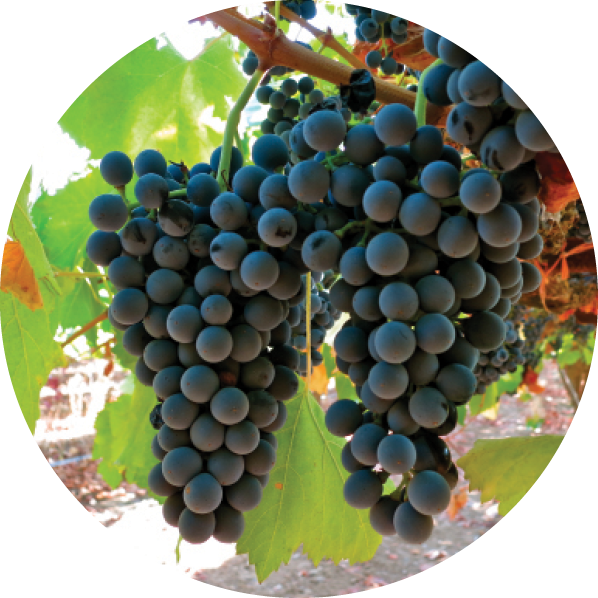
I have saved perhaps the most offbeat of my reds for last. Tinta Cão has long been favored as one of the premier varieties for making Port wine in Portugal. While over 100 varieties of grapes are allowed in Port, Tinta Cão is one of the top five. It is overshadowed in production, however, by others such as Tinta Francesa and Tinta Roriz (Tempranillo). Lower yields and a tendency to early oxidation steer Port makers away from Tinta Cão to some extent. Again, there is a bit of name confusion. Although Tinta Cão is most common, you sometimes see Tinto Cão. Written that way, it means “red dog,” and the word for dog, cão, is masculine. I only speak enough Portuguese to get me in trouble, but I suspect the confusion in names comes about because grape, uva, is feminine. So, “the red dog”
is masculine, but “the red dog grape” could conceivably be feminine: Tinta Cão.
In the Douro Valley of Portugal, alongside other Port varieties, this one is said to tolerate a bit cooler climate — but it still requires considerable heat to reach full ripeness. In California, acreage is so small that it does not even have a listing; it is listed in the USDA grape acreage statistics in the “all other red vinifera” category. To put it in perspective in California, the Souzao Port variety is listed with 89 acres (36 ha) and Touriga Nacional has 256 acres (104 ha). From Sonia Baron’s Bom Vinho vineyard in Amador County (as mentioned on page 37), I managed to get 250 lbs (113 kg) of 2016 Tinta Cão, but no Souzao this year (I’ll try again in 2017).
I have been reading recently that a number of Portuguese wineries have been experimenting with making bold, dark table wines from traditional Port varieties. So when I sourced my grapes that is exactly what I set out to do. The grapes I bought came in at 26 °Brix, so I added water to get to 25 °Brix. Acid was fine at 6.8 g/L (0.68 g/100 mL or percent). I asked Dr. Nichola Hall of Scott Laboratories if she had heard what yeast choices Portuguese winemakers were using for their dry Port-grape reds. She said they have been enjoying success with L2226 (Rhône) yeast, so that is what I used. Sonia had already crushed and destemmed the grapes and used enzymes when I got them, so I added FT Rouge Soft sacrificial tannins and Opti-Red inactivated yeast nutrient. Fermentation proceeded smoothly with twice-daily punch-downs and I pressed after 10 days. The wine underwent malolactic fermentation in glass demijohns and I racked it to carboys. While it matures in the cellar, I will probably add some oak sticks. At this point, I am very excited about my most offbeat of offbeat reds! (See the tasting notes below for comments on a carboy sample from this wine.)
Tinta Cão, being the most offbeat in my list of grapes, will probably be a challenge to source in any form, and there are no Tinta Cão kits on the market. You can do as I did and reach out to local or regional producers to ask if you can purchase grapes. Or, take a page out of my playbook and go looking for some local offbeat grapes that are growing in your area that you might not have tried growing yet — such as any lesser known Rhône or Italian variety, or try a native or hybrid grape like Norton, Marechal Foch!
Tasting Notes 2016 Tinta Cão, Amador County, Bom Vinho Vineyard
(carboy sample): Very dark purple color with aromas of tobacco and white pepper. Flavors include black cherry and tart blackberry. A strong tannic grip and a long finish, showing plum-skin tartness and some astringency. Air exposure brought out Port-like aromas, featuring some higher notes and apparent alcohol. This wine will definitely be one for aging!


